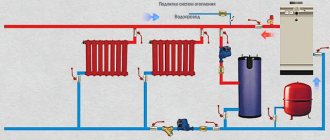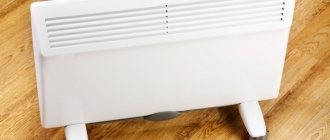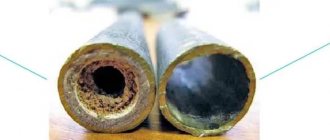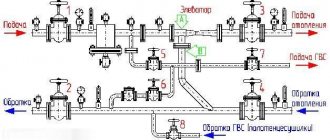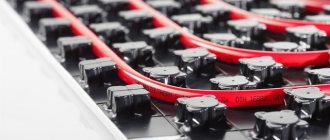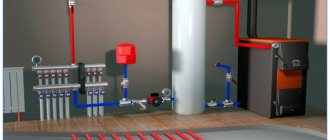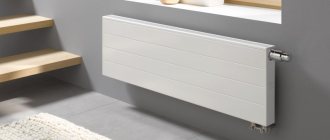Without a high-quality heating system, no home will be as comfortable and cozy as possible. Especially if it is located in Russia - after all, our country does not have a mild climate. When planning the heating system in our own home and what the heating radiator connection system will be, we try to make sure that it heats the house or apartment well, is of high quality and works without failures.
Radiator
But many owners add one more requirement, which, it should be noted, is quite logical. The heating system must also be economical. That is, its acquisition, installation, further operation, and which connection of heating radiators is better should not cost the owner a pretty penny, as they say.
One of the most common ways to save on a heating system is to purchase and install it without the involvement of specialists.
And it should be noted that even those who have never dealt with heating systems before cope with this task perfectly. Of course, in order to do everything correctly, you need to familiarize yourself with some information, including heating radiator connection diagrams. Let's look at ways to connect heating radiators and how best to connect a heating radiator for you.
Factors affecting radiator efficiency
The main requirements for a heating system are, of course, its efficiency and economy. Therefore, its design must be approached thoughtfully so as not to miss all sorts of subtleties and features of a particular living space. If you do not have sufficient skills to create a competent project, it is better to entrust this work to specialists who have already proven themselves and have positive feedback from clients. You should not rely on the advice of friends who recommend certain methods of connecting radiators, since in each specific case the initial conditions will be different. Simply put, what suits one person may not necessarily suit another.
However, if you still want to install pipes to heating radiators yourself, pay attention to the following factors:
- the size of radiators and their thermal power;
- placement of heating appliances inside the house;
- connection diagram.
The modern consumer has a variety of heating appliance models to choose from - these include wall-mounted radiators made of various materials, and baseboard or floor convectors. The difference between them is not only in size and appearance, but also in the methods of liner, as well as the degree of heat transfer. All these factors will influence the choice of options for connecting heating radiators.
Depending on the size of the heated room, the presence or absence of an insulating layer on the external walls of the building, power, as well as the type of connection recommended by the radiator manufacturer, the number and dimensions of such devices will vary.
As a rule, radiators are placed under windows or in the walls between them if the windows are located at a great distance from each other, as well as in corners or along a blank wall of a room, in a bathroom, hallway, storage room, and often in the stairwells of apartment buildings.
To direct the thermal energy from the radiator into the room, it is advisable to attach a special reflective screen between the device and the wall. Such a screen can be made from any heat-reflecting foil material - for example, penofol, isospan or any other.
Before connecting the radiator to the heating system, pay attention to some features of its installation:
- within the same residential premises, the level of placement of all batteries must be the same;
- the fins on convectors must be directed vertically;
- the middle of the radiator must coincide with the center point of the window or can be shifted 2 cm to the right or left;
- the total length of the battery should be 75% of the width of the window opening;
- the distance from the window sill to the radiator must be at least 5 cm, and there must be at least a 6 cm gap between the device and the floor. It is best to leave 10-12 cm.
Please note that the correct choice of methods for connecting heating radiators in an apartment building will depend not only on the heat transfer of the battery, but also on the level of heat loss.
There are often cases when apartment owners assemble and connect a heating system, following the recommendations of friends. In this case, the result turns out to be much worse than expected. This means that errors were made during the installation process, the power of the devices is not enough to heat a particular room, or the scheme for connecting the heating pipes to the radiators is inappropriate for a given house.
Differences between the main types of battery connections
All possible types of connection for heating radiators differ in the type of pipe routing. It may consist of one or two pipes. In turn, each of the options involves division into systems with vertical risers or horizontal mains. Quite often, horizontal wiring of the heating system in an apartment building is used, and it has proven itself well.
Based on which option for connecting the pipes to the radiators was chosen, the diagram of their connection will directly depend. In heating systems with one-pipe and two-pipe circuits, the bottom, side and diagonal method of connecting radiators is used. Whatever option you choose, the main thing is that enough heat gets into the room for high-quality heating.
The described types of pipe routing are classified as a tee connection system. However, there is another type - this is a collector circuit, or radial wiring. When using it, the heating circuit is laid to each radiator separately. In this regard, collector types of connecting batteries have a higher cost, since such connections will require quite a lot of pipes. In addition, they will pass through the entire room. However, usually in such cases the heating circuit is laid in the floor and does not spoil the interior of the room.
Despite the fact that the described manifold connection diagram assumes the presence of a large number of pipes, it is increasingly used during the design of heating systems. In particular, this type of radiator connection is used to create a water-heated floor. It is used as an additional heat source, or as the main one - it all depends on the project.
Manufacturers
Among the many brands, the following brands have proven themselves well:
Lideya (Russia). This manufacturer has received many positive reviews, as all of its products are of high quality finish. The radiator panels are coated with a unique two-layer varnish, and the devices can operate in one-pipe or two-pipe heating systems.
- Biasi S.p. A. (Italy). The radiators of this company are created using the latest technologies, so their heat transfer is high and the rooms are heated instantly. The devices can also operate at low temperatures; their operating pressure limit is 9 bar.
- Korado (Czech Republic). Batteries have either one, two or three panels. The main features of the products are their wide range of colors, small volume of coolant, and convenient brackets. The pressure limit reaches 8.7 bar, and the water heats up to +110 C.
Single-pipe scheme
A single-pipe heating system is a heating system in which all radiators, without exception, are connected to one pipeline. In this case, the heated coolant at the inlet and cooled down at the return moves through the same pipe, gradually passing through all heating devices. In this case, it is very important that the internal cross-section of the pipe is sufficient to perform its main function. Otherwise, all heating will be ineffective.
A heating system with a single-pipe circuit has certain pros and cons. It would be a mistake to think that such a system can significantly reduce the cost of laying pipes and installing heating devices. The fact is that the system will function effectively only if it is properly connected, taking into account a large number of subtleties. Otherwise, it will not be able to heat the apartment properly.
Cost savings when installing a single-pipe heating system do occur, but only if a vertical supply riser is used. In particular, in five-story buildings this type of wiring is often practiced in order to save materials. In this case, the heated coolant is supplied upward through the main riser, where it is distributed to all other risers. The hot water in the circuit gradually passes through the radiators on each floor, starting from the top.
As the coolant reaches the lower floors, its temperature gradually decreases. To compensate for the temperature difference, radiators with a larger area are installed on the lower floors. Another feature of a single-pipe heating system is that it is recommended to install bypasses on all radiators. They allow you to easily remove batteries if repairs are necessary without stopping the entire system.
If heating with a single-pipe circuit is carried out according to a horizontal wiring scheme, the movement of the coolant can be parallel or dead-end. This system has proven itself in pipelines up to 30 m long. In this case, the number of connected radiators can be 4-5 pieces.
Two-pipe heating systems
Inside a two-pipe circuit, the coolant moves through two separate pipelines. One of them is used for the supply flow with hot coolant, and the other is used for the return flow with cooled water, which moves towards the heating tank. Thus, when installing heating radiators with a bottom connection or any other type of insertion, all batteries are heated evenly, since water enters them at approximately the same temperature.
It is worth noting that a two-pipe circuit when connecting batteries with bottom connections, as well as when using other circuits, is the most acceptable. The fact is that this type of connection ensures a minimal amount of heat loss. The water circulation scheme can be either associated or dead-end.
Please note that if you have a two-pipe wiring, it is possible to regulate the thermal performance of the radiators used.
Some owners of private houses believe that projects with two-pipe types of radiator connections are much more expensive, since more pipes are required for their implementation. However, if you look in more detail, it turns out that their cost is not much higher than when installing single-pipe systems.
The fact is that a single-pipe system requires pipes with a large cross-section and a large radiator. At the same time, the price of thinner pipes required for a two-pipe system is much lower. In addition, in the end, excess costs will be recouped due to better coolant circulation and minimal heat loss.
With a two-pipe system, several options are used for how to connect aluminum heating radiators. The connection can be diagonal, side or bottom. In this case, the use of vertical and horizontal joints is allowed. From an efficiency point of view, a diagonal connection is considered the best option. In this case, the heat is evenly distributed throughout all heating devices with minimal losses.
The lateral, or one-sided, connection method is used with equal success in both one-pipe and two-pipe distributions. Its main difference is that the supply and return circuits are embedded on one side of the radiator.
Lateral connection is often used in apartment buildings with a vertical supply riser. Please note that before connecting a heating radiator with a side connection, it is necessary to install a bypass and tap on it. This will allow you to freely remove the battery for washing, painting or replacement without disconnecting the entire system.
It is noteworthy that the efficiency of one-sided insertion is maximum only for batteries with 5-6 sections. If the length of the radiator is much longer, there will be significant heat loss with such a connection.
Features of the option with bottom pipe connection
As a rule, connecting a radiator with a bottom connection is carried out in cases where unpresentable heating pipes need to be hidden in the floor or wall so as not to disturb the interior of the room.
On sale you can find a large number of heating devices in which manufacturers provide a lower supply to the heating radiators. They are available in various sizes and configurations. At the same time, in order not to damage the battery, it is worth looking at the product passport, which describes the connection method for a particular model of equipment. Typically, the battery connection unit has ball valves that allow it to be removed if necessary. Thus, even without experience in such work, using the instructions, you can connect bimetallic heating radiators with a bottom connection.
The circulation of water inside many modern radiators with a bottom connection occurs in the same way as with a diagonal connection. This effect is achieved due to an obstacle located inside the radiator, which ensures the passage of water throughout the heating device. After this, the cooled coolant enters the return circuit.
Please note that in heating systems with natural circulation, it is not advisable to connect radiators from the bottom. However, significant heat losses from such a wiring scheme can be compensated by increasing the thermal power of the batteries.
Useful tips
For long-term operation, it is not enough to connect the device correctly. By providing proper care, you can significantly extend the life of the radiator.
At the end of the heating season, water from the central heating is drained for the entire summer period. This is necessary for pipe maintenance and repair. However, this process cannot be called useful for radiators - most devices undergo internal corrosion during this period.
Creating favorable conditions for the summer period is quite simple.
To do this, it is necessary to carry out the following activities:
- after the radiators have completely cooled down, all valves on the direct and return water supply should be closed;
- After this, all air vents must be opened.
Thus, the remaining water in the radiator will be released into the air vent due to thermal expansion, which occurs due to the chemical reaction of the metal with water.
At the beginning of the heating season, it is necessary to close the air vent before filling the batteries with hot water. Don't forget to flush your radiators at least once every two years.
This happens as follows:
- the lower and upper valves are closed;
- open air vents;
- drain the water through a plug or drain valve;
- unscrew the detachable fasteners;
- remove the radiator from the bracket;
- After all the above manipulations, you can rinse the device with water through a hose that can be easily attached to the water tap.
When washing, the use of abrasive products is strictly prohibited.
Don't forget about external cleaning. Dust clogging into the battery fins reduces the heat transfer of the device, so regular washing of the case will not harm the device.
Cast iron radiators require painting. For this purpose, special paint is used for batteries and heating structures, which can withstand high temperatures. Such paints do not turn yellow, do not crack, and do not wash off.
Diagonal connection
As we have already noted, the diagonal method of connecting radiators has the lowest heat loss. With this scheme, the hot coolant enters from one side of the radiator, passes through all sections, and then exits through the pipe from the opposite side. This type of connection is suitable for both single- and two-pipe heating systems.
Diagonal connection of radiators can be done in 2 options:
- The hot coolant flow enters the upper hole of the radiator, and then, having passed through all sections, exits the lower side hole on the opposite side.
- The coolant enters the radiator through the lower hole on one side and flows out from the top on the opposite side.
Connecting in a diagonal manner is advisable in cases where the batteries consist of a large number of sections - 12 or more.
Tests
If until now everything was done with your own hands, at this stage it is better to invite a housing and maintenance mechanic. By turning off the American taps, you can open the connecting tap. It is better to leave the opening of the return pipe to a mechanic.
If there are no leaks at the connection points, it will be possible to open the valve on the batteries and close the bypass valve. The coolant will begin to flow into the heating system. To bleed air, you should use the Mayevsky tap.
Once the heating circuit in all rooms has warmed up, the plumber will open the straight pipe. This will restore pressure in the system. The control tests can be considered completed. If the installation was done correctly, the apartment will be comfortable at minimal cost.
Natural and forced coolant circulation
It is worth noting that the method of connecting pipes to radiators will also depend on how the coolant circulates inside the heating circuit. There are two types of circulation - natural and forced.
Natural circulation of liquid inside the heating circuit is achieved through the application of physical laws, and no additional equipment needs to be installed. This is only possible when using water as a coolant. If any antifreeze is used, it will not be able to circulate freely through the pipes.
Heating with natural circulation includes a boiler for heating water, an expansion tank, 2 pipelines for supply and return, as well as radiators. In this case, a working boiler gradually heats the water, which expands and moves along the riser, passing through all the radiators in the system. Then the cooled water flows by gravity back into the boiler.
To ensure free movement of water, horizontal pipes are installed with a slight slope towards the direction of movement of the coolant. A natural circulation heating system is self-regulating because the amount of water changes depending on its temperature. When water is heated, the circulation pressure increases, which ensures uniform heating of the room.
In systems with natural circulation of liquid, it is possible to install a radiator with a bottom connection, provided there is a two-pipe connection, and also use a scheme with a top connection in a one- and two-pipe circuit. As a rule, this type of circulation is carried out only in small houses.
Please note that the batteries must have air vents through which air pockets can be removed. As an option, you can equip the risers with automatic air vents. It is advisable to place the heating boiler below the level of the heated room, for example, in the basement.
If the area of the house exceeds 100 m2, then the method of circulation of the coolant must be forced. In this case, you will need to install a special circulation pump, which will ensure the movement of antifreeze or water along the circuit. The power of the pump depends on the size of the house.
The circulation pump can be mounted on both the supply and return pipes. It is very important to install automatic bleeders at the top point of the pipeline or provide Mayevsky taps on each radiator in order to remove air pockets manually.
The use of a circulation pump is justified in both one- and two-pipe systems with vertical and horizontal radiator connections.
Installation rules
Before connecting the radiator to the system, it is assembled in a lying state with the installation of all fittings. Ultimately, only two straight press fittings or union nut connections should remain: on the supply and return lines.
The lower connection valve replaces the radiator liner. Its sealing occurs in the standard way for this unit - using an o-ring seal. It is advisable to mark the position of the through hole on the shank on the valve nut so that after tightening it is positioned strictly vertically. To adjust the position, you can use seals of different thicknesses and adjust the degree of tightening.
The injection unit is connected in a similar way, but quite often it does not have a nut that replaces the fitting. With a one-way bottom connection, the outlet on the reverse side is plugged with a plug, like one of the top ones, and a Mayevsky tap is installed in the remaining one. The further assembly scheme is simple: all the necessary shut-off and control equipment is packed onto the threaded fittings of the valve, injection unit or lower outlets onto tow with sealing paste. Ultimately, the radiator is installed in place as an assembly and fixed using a wall or floor mounting method, then it is connected to the system.
rmnt.ru
Why is it important to properly connect heating radiators?
Whatever connection method and type of radiator you choose, it is very important to carry out proper calculations and correctly install the equipment. It is important to take into account the characteristics of a particular room in order to choose the best option. Then the system will be as efficient as possible and will avoid significant heat loss in the future.
If you want to assemble a heating system in a large, expensive mansion, it is better to entrust the design to specialists.
For small houses, you can handle the choice of connection diagram and installation of batteries yourself. You just need to consider the quality of a particular connection scheme and study the features of installation work.
Please note that the piping and radiators must be made of similar material. For example, plastic pipes cannot be connected to cast iron batteries, as this is fraught with trouble.
Thus, provided that the features of a particular house are taken into account, you can connect heating radiators yourself. A well-chosen scheme for connecting pipes to radiators will minimize heat loss so that heating devices can operate with maximum efficiency.
